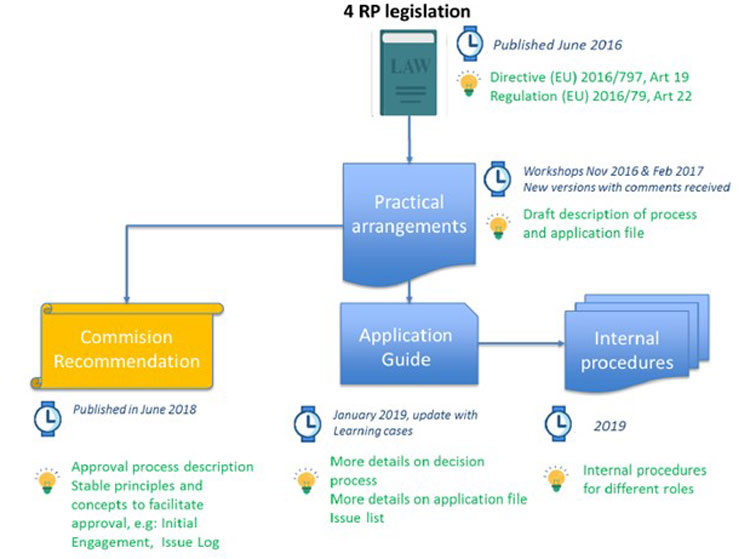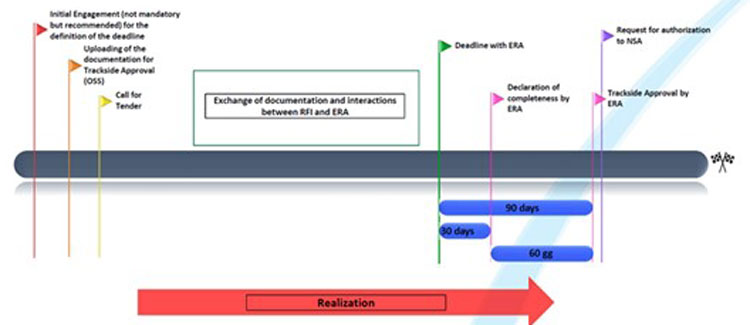Exploring RFI’s trackside approval process for ETCS/ERTMS
Posted: 30 January 2023 | Alessandro Gallina, Claudio Evangelisti, Fabio Senesi, Francesco Di Flaviano, Gianvito Gallo, Stefano Marcoccio, Ylenia Ferlazzo | No comments yet
In this article, colleagues from Rete Ferroviaria Italiana (RFI) explain the trackside approval process for ETCS/ERTMS, in particular with a general overview related to its stakeholders and details about the steps and documents to obtain the necessary approval.
The authors aim to share the Italian railway infrastructure manager’s experiences mainly on the Ventimiglia–Bordighera line, which was the first positive ETCS/ERTMS approval given by the European Union Agency for Railways (ERA), but also to explain the other open procedures.
The trackside approvals process is a fundamental procedure to guarantee interoperability on the European railway network. Starting from the tender launched in June 2019, this procedure is mandatory to obtain from ANSFISA, the Italian rail and road safety authority, the authorisation to place in service ERTMS and/or GSM-R networks on each trackside for the first time. Trackside approval is supervised by ERA; its goal is to verify that implemented technical solutions are compliant with the TSI.
RFI has developed an accelerated national plan to implement ERTMS on the complete railway network by 2036, not only on high-speed and high-capacity tracks but also on regional tracks.
Rete Ferroviaria Italiana (RFI), the Italian railway infrastructure manager and subsidiary of Ferrovie dello Stato (FS), in particular the Operative Structure PNE (ERTMS National Plan), plays the role of ‘Applicant’ to request approval for ERTMS national implementations.
During this process, ANSFISA offers opinions and solutions about documentation uploaded by RFI. These can be considered by ERA before taking a final decision. A positive approval by ERA is required by ANSFISA to issue authorisation to place in service for each ERTMS national implementation.
Trackside approval is foreseen by article 19 of Directive (EU) 2016/797. ERA requires documentation, divided into 14 items, through the One-Stop Shop (OSS). The first upload of documentation must be performed before the call for tender, even if not all documentation is available.
Figure 1 shows the main documents related to the ERTMS trackside approval.


Figure 1
There are three steps to obtain the approval, plus an optional fourth step, as shown in Figure 2. Only if needed, in case of a negative decision being issued, is it possible to appeal to the Boards of Appeal (the fourth step).


Figure 2
ERA recommends a meeting of initial engagement to manage the process in which it is possible to agree with ERA on a document submission strategy, particularly if not all the documentation is available before the call for tender.
Figure 3 shows the typical timeline for a trackside approval process. If the information is available, a decision can be made before the deadline. Any project that re-uses the documentation could reach a decision before.


Figure 3
After the first submission of the documentation, the trackside approval process is generally to manage and answer ERA’s comments and to eventually upload new documentation.
The following points provide a short introduction to each item, taking into account the Ventimiglia–Bordighera line experience.
- In the first upload to OSS for Item 1 (application scope description) a document with a general description of the project was provided
- For Item 2 (evidence that the draft tender or contract or both include the relevant control command and signalling TSI, and necessary details on baseline, releases or versions) a document with a general indication of TSI was provided
- Item 3 (projects plan indicating deliverables, milestones and deadlines of the application) is just an outline of the project that ERA needs in order to plan its necessary effort. Given the fact that in general, it is not possible to produce all necessary documentation before the tender, ERA needs to know when the project needs to be put in service in order to fix a deadline for its decision
- Items 4, 5 and 6 are linked because, for the first two, the excel ‘Functions list and issues log’ needs to be filled while item 6 comes is simply a repository of the documents referenced in items 4 and 5
- Item 7 (test strategy and test plan) is one of the last documents to be produced; it is a description of the tests to be performed in a laboratory and in the field according to the TSI. The document can be critical to respect deadlines
- Item 8 (conditions necessary for the technical and operational compatibility of the subsystems with the vehicles intended to operate in the trackside) is satisfied with the use of the NRD in the case of the Ventimiglia–Bordighera line. There are only a few questions from ERA about the ESC Tests and the vehicles intended to operate on the line
- Item 9 (a previous ERTMS trackside authorisation or opinions by a NSA, relevant to the technical solutions envisaged) is an item that can be useful if some of the technical solutions have been authorised by a NSA in the past. It was not used in the case of the Ventimiglia–Bordighera line
- Item 10 (EC certificates and EC declarations of conformity of the interoperability constituents) was available after the decision and not sent
- Item 11 (EC certificates and EC declarations of verification of the trackside subsystem) was available after the decision and not sent
- Item 12 (national rules related to ERTMS that must be considered in the application scope) is not needed if the trackside subsystem is expected to be completely compliant to the TSI
- Item 13 (exemption from the application of one or more TSIs or parts of them) is not needed in general if there is no exemption for the specific project
- Item 14 (previous approval(s) identification) is not applicable to the Ventimiglia–Bordighera line because the project was not subjected to trackside approvals in the past.
RFI obtained the first positive ETCS approval, in particular, for the implementation of ETCS Level 1 LS (Limited Supervision) in Ventimiglia Station and on the Ventimiglia–Bordighera line. This procedure was a study case for other European infrastructure managers during the Workshop on Trackside Approval on 26 January 2022 organised by the Mediterranean Corridor. RFI reached this important goal thanks to ERA’s collaborative approach.
RFI has developed an accelerated national plan to implement ERTMS on the complete railway network by 2036, not only on high-speed and high-capacity tracks but also on regional tracks. All operative structures, working on this implementation plan, collaborate to achieve this objective, writing national ERTMS standards, developing and managing ETCS/ERTMS projects and integrations between track and onboard subsystems.
RFI has called for a tender (approximately €2.5 billion) for signing two framework agreements. All projects of the first and second framework agreement are uploaded on the OSS.
In conclusion
RFI’s experience teaches us that the core of the trackside approval process is items 4, 5 and 6 with the excel functions list and issues log. Moreover, knowledge of the current error corrections and CRs helps in the process. It may be useful to find some solutions to the problems indicated by the CRs before applying them to a specific project. Finally, planning is strategic, in fact, it is necessary in order to avoid the latest documents being produced too late, compromising the deadlines. In the end, RFI in that workshop, such as in all the other bilateral meetings, disseminates its experience and knowledge on trackside approvals.














Related topics
European Rail Traffic Management System (ERTMS), European Train Control System (ETCS), Global System for Mobile Communications – Railway (GSM-R), Regulation & Legislation, Signalling, Control & Communications
Related organisations
ANSFISA, European Union Agency for Railways (ERA), Rete Ferroviaria Italiana (RFI)








